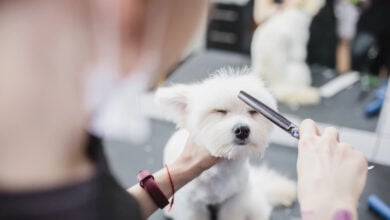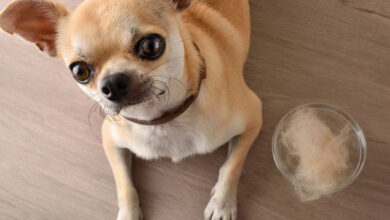How Much Do Dachshunds Shed? The Answer Might Surprise You
When you purchase through links on our site, we may earn a commission. Here’s how it works.
They may be small, but Dachshunds shed just enough to keep your lint roller working overtime. But, how much do Dachshunds really shed?
Table of Contents
Sure, they’re not Huskies, but don’t let those little legs fool you. Smooth, long-haired, or wire-haired, every Doxie comes with a side of shed. I’m breaking it down by coat type, exposing some fluffy myths, and giving you easy, fur-fighting tips to help you reclaim your furniture (and your sanity).
Do Dachshunds Shed?
Yes, Dachshunds shed, and depending on the coat type, some shed more than others. If you’re asking, “Do Dachshunds shed a lot?” the honest answer is: not like a Husky, but definitely enough to leave traces on your clothes, couch, and car seats.
All three coat varieties, smooth, long-haired, and wire-haired, shed, just in different ways.
Most Dachshund owners are surprised not by how much their dog sheds, but by how steady it is. The real trick is knowing what to expect and how to keep it from taking over your home.

Which Doxies Shed The Most? 3 Coat Types
When it comes to how much Dachshunds shed, coat type is everything. Not all weenie dogs shed equally. Some drop a steady stream of hair, while others are more low-key about it (but still leave their mark).
There are three varieties of Dachshund coats: wire-haired, long-haired, and short-haired. Each type requires a specific type of care and sheds at a different rate. Here’s how the three types stack up:
1. Smooth-Haired Dachshunds
Short, sleek coats that shed a little all the time. You won’t see big clumps, but you’ll always find fur on your pants. Since their coat is short and fine, and they shed year-round, the hairs they leave behind are minimal.
Short-haired Dachshunds are referred to as smooth-coated and have a short, sleek coat without an additional undercoat. Often described as “wash-and-wear” dogs, smooth Dachshunds have easy-to-maintain coats.
Toweling them off and brushing them with a hound mitt periodically knocks off most of the dirt and excess hair.

My own short-haired Doxie, Chips, sheds pretty minimally year-round. Her sleek coat doesn’t leave much behind. Especially compared to my other dog, Bonkers, a Bull Terrier mix who seems to explode fur like it’s his full-time job.
With Chips, I might find a few hairs on the couch, but nothing like the coat detonation Bonkers leaves behind.
2. Long-Haired Dachshunds
These elegant fluffballs shed the most. Their soft, flowing coats trap dead hair that eventually ends up on your furniture (and in your vacuum).
As the name suggests, the long-haired Dachshund has a sleek, soft coat, longest under their neck, chest, and body. The hair on their ears and tail is long and silky, and their gracefully carried tail flies happily behind them like a flag.
Their coat is not so heavy as to hide their muscular shape, and their long hair should never be curly. Most long-haired Doxies have an additional undercoat and shed seasonally.
As you may expect, long-haired Dachshunds will shed more noticeably than their smooth-coated cousins simply because their long hair will be more obvious on clothes and furniture. Although some long-haired Dachshunds have a single coat, most are double-coated dogs.
This dense undercoat keeps them warm in cold weather, but they will shed it twice a year. When their undercoat sheds out, they will lose a considerable amount of hair all at once. Brushing out their undercoat can shorten the duration of their shedding season.
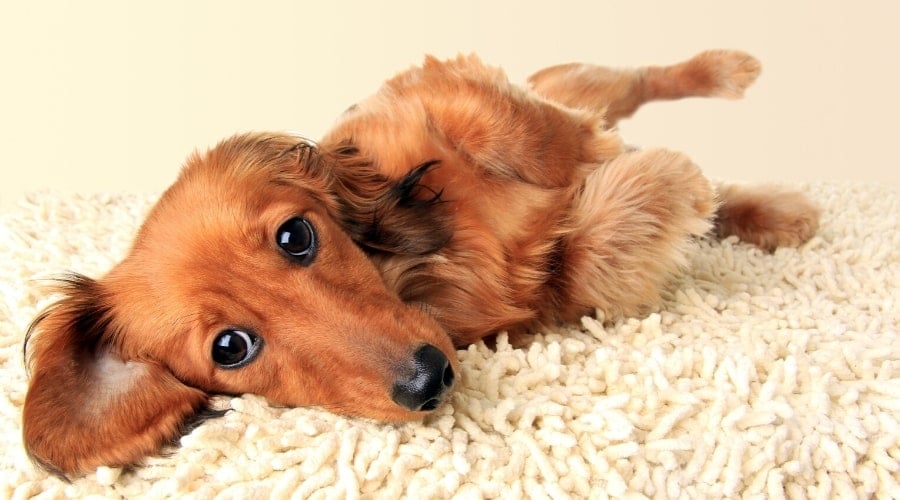
3. Wire-Haired Dachshunds
Thanks to their wiry, double-layered coats, they shed the least. However, they still require hand-stripping or regular grooming to keep them in good condition.
The wire-haired Dachshund’s coat is uniformly tight, short, and thick. The rough, hard outer coat protects them from the elements and is the reason they shed the least of the three varieties.
Under that rough outer coat is a finer, softer, shorter undercoat everywhere. Maintaining their undercoat helps minimize their shedding.
As their undercoat loosens, their rough outer coat will trap it. Less of it will fall on surfaces in the home than with the smooth or long-haired variety. When their undercoat is ready to be removed, your best bet to minimize shedding is to have their coat stripped by a professional groomer.
Their distinctive beards and eyebrows give them a distinguished, if somewhat grizzled, air of dignity.
Quick Tip: If you’re looking for a Dachshund that sheds the least, go wire-haired. However, every Doxie, regardless of coat type, requires a fur-control strategy.
Does Dachshund Color Affect Shedding?
No, Dachshund color has zero impact on how much they shed. Whether your Doxie is black and tan, dapple, cream, chocolate, or piebald, shedding levels are determined by coat type, not a Dachshund’s coat color.
That said, light-colored Dachshunds may appear to shed more because their fur stands out more visibly against dark clothing or furniture. However, it’s just a matter of perception, not actual volume.
Quick Takeaway: It’s the texture, not the tint, that determines the fur fallout.
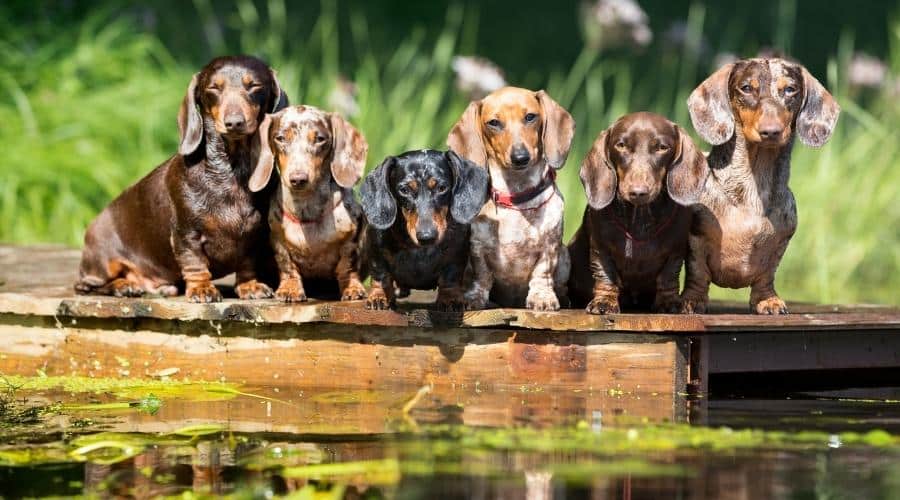
Do Dachshund Puppies Shed Differently?
Yes, they do, but not in a dramatic way. Dachshund puppies are born with a softer, finer coat compared to their parents. Their coat gradually changes as they mature.
Around 6 to 12 months old, that baby fluff starts to shed out, making room for their adult coat, whether that’s smooth, long, or wire-haired.
You might not notice much fur at first, especially with smooth-haired pups, but as their adult coat fills in, the shedding pattern becomes more consistent. This is also the stage where grooming routines really start to matter.
Pro Tip: Start brushing early, even if shedding seems minimal, so your pup gets used to it before their full coat growth begins.
When Dachshund Shedding Changes Suddenly
Dachshunds shed year-round, but sometimes you’ll notice a sudden spike, and it can catch even seasoned Doxie owners off guard.
Sometimes, it’s totally normal:
- Seasonal shifts (spring and fall are big ones)
- Stress or anxiety (new environment, loud noises, vet visits)
- Hormonal changes (especially after heat cycles or spaying/neutering)
- Diet changes (especially low-quality or sudden switches)
Although shedding itself is a normal process, abnormal shedding can indicate a health problem. Sometimes, excessive shedding originates in the skin, also known as the dermis. Inflammation of the skin is called dermatitis (dermis = skin, itis = inflammation) and can have a root cause that is either internal or external in origin.
Here’s when shedding is a red flag:
- Bald spots or thinning patches
- Red, flaky, or irritated skin
- Persistent itching or licking
- Changes in behavior or appetite
If shedding comes with skin issues, discomfort, or seems excessive compared to usual, don’t brush it off, literally. A quick vet check could uncover allergies, parasites, thyroid problems, or other treatable issues.
Rule of Thumb: Sudden shedding alone is usually fixable. Sudden shedding with other symptoms? Call your vet.
When Shedding Isn’t Just Shedding: Health Issues To Watch
Sometimes, your Dachshund’s hair loss isn’t just normal shedding; it’s a sign that something’s off under the fur.
If you notice bald patches, red or flaky skin, or fur that seems oily, scaly, or smells strange, it could point to deeper issues like:
- Hormonal imbalances
- Autoimmune disorders
- Dermatitis
- Aging-related skin conditions
A quick skin check can reveal a lot. If your Doxie’s skin looks thick, greasy, or irritated, it’s time to visit the vet. Many of these issues are treatable with supplements or targeted care.
Food can also be a sneaky culprit. Food sensitivities can trigger itching, inflammation, and fur fallout. More on this later, and what food you should consider to help reduce shedding.
And don’t forget the outside invaders:
- Flea allergies
- Mange
- Fungal or bacterial skin infections
Even if fleas are gone, lingering itchiness or hair loss may mean it’s time for a vet to do a skin scrape and figure out what’s really going on.

Bottom line: If it’s more than just a few stray hairs, get it checked. Your Doxie could be dealing with something fixable.
Are Dachshunds Hypoallergenic?
Despite what some pet adoption sites or TikTok videos might claim, Dachshunds are not hypoallergenic. All Doxies, smooth, long-haired, or wire-haired, produce dander, which is the real allergy trigger, not just fur.
While wire-haired Dachshunds shed the least, even they can cause sneezing fits in allergy-sensitive folks. And yes, even short-haired Doxies can leave traces of hair and dander in your home.
That said, with regular grooming, a clean home, and good air filters, many allergy sufferers live happily with a Doxie. Just don’t adopt one thinking it’s a guarantee of a sneeze-free life.
Fur-Fighting Toolkit: 4 Lifesavers
Dachshunds in general and wire-haired Dachshunds, in particular, are a low-shedding breed, but they still need to be groomed according to their coat types.
Even if your Dachshund doesn’t shed a ton, a consistent grooming routine makes all the difference. The right tools can significantly reduce loose fur floating around your home (and clinging to your leggings).
Here are the best ways to manage their coat and reduce shedding in smooth-coated, long-haired, and wire-haired varieties.
1. Brushes (By Coat Type)
How often you brush your Dachshund and which tools you’ll need depend entirely on their coat type. Choose grooming tools that match their fur, not just the aesthetic.
Wire-Haired Dachshunds
A bristle brush works wonders here. Daily brushing helps remove shed hairs that otherwise get trapped in their rough outer coat (and end up on your clothes). It also stimulates circulation and distributes oils, giving even their scruffy coat a healthy shine.
During seasonal shedding, wire-haired Doxies lose their undercoat and may benefit from professional grooming. At home, use a fine-toothed flea comb to catch hairs that cling tightly to their coat.
Long-Haired Dachshunds
Their long, silky fur needs almost daily attention, especially if they’re active outdoors. Start with a slicker brush to remove mats, tangles, and debris, then follow up with a bristle brush to smooth everything down.
Pay extra attention to their ears and feet, which tend to mat quickly. Catch small tangles before they become full-on fur disasters.
Smooth-Haired Dachshunds
Easiest coat, but still worth the effort. Smooth Doxies shed a little every day, so a quick daily rub with a hound mitt or grooming glove goes a long way. It feels like petting to them, but you’re also spreading natural oils and boosting coat health.
Pro Tip: Even low-shedding dogs benefit from regular brushing as it keeps their coat healthy and reduces fur bombs around your house.
2. Shampoo
Always choose a dog-safe shampoo. If your pup’s skin is sensitive, choose a shampoo specifically formulated for sensitive skin. Even with a gentle shampoo, shampooing them too frequently can strip the natural oils from their coat and dry their skin, so limit baths to once every few months.
3. Lint Rollers
If you’ve got a Dachshund, you need a lint roller in every room. Smooth-coated Doxies leave behind tiny, sneaky hairs that seem to magnetize onto light clothes. A classic sticky roller works fine, but reusable silicone rollers or fabric brushes are more eco-friendly and surprisingly effective.
4. Pet Vacuums
Regular vacuums can only do so much. When you’ve got fur in corners, on upholstery, and clinging to rugs, a pet-specific vacuum is a game-changer. Look for models with HEPA filters (great for removing dander), tangle-free brush rolls, and strong suction to grab embedded hair effectively.
Cordless handheld models are perfect for quick passes over dog beds or car seats, while uprights with upholstery tools keep your home Doxie-hair-free (or close enough). We’ve found the best vacuums for pet hair.
Can Diet Really Fix Your Dachshund’s Shedding?
Surprisingly, yes. A healthy, balanced diet plays a massive role in coat health and shedding control. What your Doxie eats shows up in their fur (or all over your couch).
Feeding dog food that does not contain known allergens is the first step in preserving coat health. Many dogs are allergic to chicken in commercial dog foods. If you’re worried your pup may have a food sensitivity, try a chicken-free formula.
Look for foods rich in:
- Omega-3 and Omega-6 fatty acids (for skin moisture and coat shine)
- High-quality animal proteins (for fur strength and regeneration)
- Vitamin E, zinc, and biotin (for skin barrier support)
If your Dachshund’s shedding seems excessive, check their food label. Cheap fillers and mystery meat can lead to dull, dry fur and increased shedding. Some owners notice a significant difference simply by switching to a premium or limited-ingredient formula. We also have a guide on the best food for Dachshunds.
The brand you choose should include omega-3 fatty acids. Omega-3 fatty acids have anti-inflammatory properties considered beneficial for dogs’ skin and coats. Research has shown that omega-3s have health benefits for dogs beyond making their coats shine. They reduce inflammation in the body, keeping your buddy more comfortable and alleviating itchy skin.
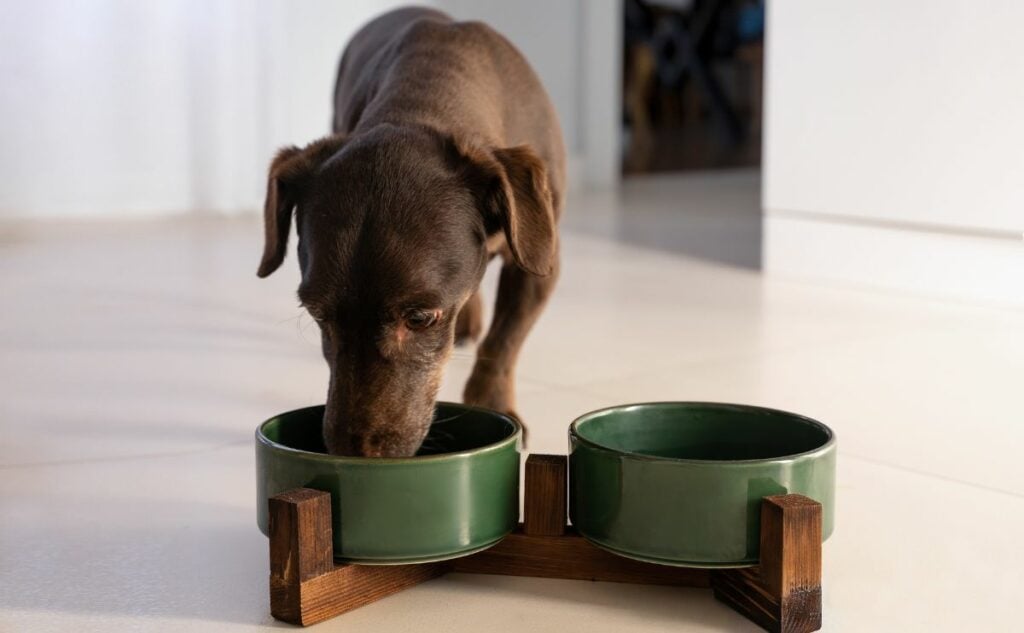
Supplements
Omega-3 supplements and treats are an easy way to add more omega-3 fats into your Doxie’s diet. Fish oils contain omega-3s, which promote a healthy coat and reduce shedding.
Some fish oil supplements contain a blend of fish and plant-based oils to provide a balanced ratio of the three main types of omega-3 fatty acids, alpha-linolenic acid (ALA), eicosapentaenoic acid (EPA), and docosahexaenoic acid (DHA).
Even with low-shedding dogs, better nutrition keeps their coat soft, glossy, and less likely to shed unnecessarily.
Do Weenie Dogs Shed? Common FAQs Answered
Do you have a question I didn’t cover? Drop it in the comments. We’d love to hear from you and may even add it to the list!
Do Dachshunds Shed A Lot?
Compared to other dog breeds, Dachshunds are moderate to minimal shedders. Long-haired Dachshunds shed the most noticeably, although they are seasonal shedders. Smooth-coated Doxies shed constantly, but not very much. The wire-haired Dachshund sheds least of all.
Do Weenie Dogs Shed Year-Round?
Yes. All coat types shed throughout the year, with slight increases in spring and fall. Wire-haired Doxies may shed less, but they still require regular brushing to manage loose hair.
Are Dachshunds Hypoallergenic?
No. Even wire-haired Doxies produce dander and saliva proteins that can trigger allergies. Shedding less doesn’t mean allergy-safe.
Does Dachshund Coat Color Affect Shedding?
Nope. Shedding has nothing to do with color, just coat type. A red long-haired Doxie will shed just as much as a black and tan one.
How Do I Reduce My Dachshund’s Shedding?
There are several small adjustments you can make to minimize Dachshund shedding. Brush your pet regularly, feed a high-quality diet rich in omega-3s, use a gentle shampoo monthly, and maintain flea prevention. Supplements can also be beneficial, but be sure to ask your veterinarian for coat-specific options.
Can Food Allergies Cause My Dachshund To Shed More?
Yes. Food sensitivities can lead to itching, inflammation, and excessive hair loss. If you suspect the kibble, try a limited-ingredient diet, but remember to consult your vet first.
Do I Need To Take My Dachshund To A Groomer?
You probably won’t need to take your Dachshund to a groomer unless your wire-haired Doxie is shedding their undercoat. Having their coat professionally stripped will shorten their shedding season.
When Is It Time To Take My Dachshund To The Vet?
If your dog is shedding more than usual, inspect the skin beneath their coat. If you notice that their skin appears thick, greasy, scaly, red, or has a foul odor, schedule a consultation with your veterinarian.
Keep Your Doxie Healthy Beyond The Fur
Shedding is just one piece of the Dachshund puzzle, and keeping them healthy and comfortable is a full-time mission. If you’re thinking ahead, don’t miss our guide to the best pet insurance for Dachshunds, especially since emergencies and other Doxie health problems can sneak up fast (and get pricey).
Looking to upgrade nap time? We’ve rounded up the best beds for Dachshunds that support their long spines and burrow-loving habits. If crate training’s on your radar, check out our top picks for the best crates for Dachshunds, with safe, cozy, and escape-proof options.
Heading out? Our guide to the best harnesses for Doxies helps keep their fragile necks protected during walks. And when it’s playtime, we’ve got the best toys for Dachshunds to keep their minds and noses working.
Got a Shedding Story? Is your Dachshund a low-key shedder or a tiny fur tornado? Share your story in the comments! We’d love to hear what coat type your Doxie has, what’s worked (or totally failed), and whether you’ve found the perfect brush, shampoo, or shedding hack. We might even feature your tip in an upcoming post!
